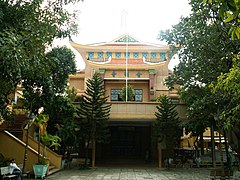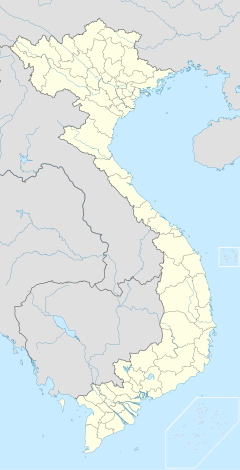Xá Lợi Pagoda
| Xá Lợi Pagoda | |
|---|---|
 |
|
| Name | |
| Proper name | Chùa Xá Lợi |
| Geography | |
| Coordinates | 10°46′41″N 106°41′12″E / 10.777973°N 106.686591°ECoordinates: 10°46′41″N 106°41′12″E / 10.777973°N 106.686591°E |
| Country | Vietnam |
| Province | Hồ Chí Minh |
| Location | Hồ Chí Minh City |
| Culture | |
| Primary deity | Buddha |
| Architecture | |
| Architectural styles | Vietnamese pagoda |
| History and governance | |
| Date built | 1956 |
The Xá Lợi Pagoda (Vietnamese: Chùa Xá Lợi; chữ Hán: ) is the largest pagoda in Hồ Chí Minh City, Vietnam. It was built in 1956 and was the headquarters of Buddhism in South Vietnam. The pagoda is located in District 3, Hồ Chí Minh City and lies on a plot of 2500 square metres. The name Xá Lợi is the Vietnamese translation for śarīra, a term used for relics of Buddhists.
The pagoda is best known for the raids, in which the Army of the Republic of Vietnam Special Forces loyal to Ngô Đình Nhu, the brother of the Roman Catholic President Ngô Đình Diệm, raided and vandalised Buddhist monasteries and pagodas on 21 August 1963.
Construction began on 5 August 1956, according to the plans drawn up by the architects Trần Văn Đường and Đỗ Bá Vinh, while the directing engineers were Dư Ngọc Ánh and Hồ Tố Thuận. The pagoda was opened on 2 May 1958, by the Most Venerable Thich Khanh Anh. The pagoda was built to enshrine a sample of the relics of Gautama Buddha, giving its name.
A series of raids in response to Vietnamese Buddhists' protests for civil rights in the face of religious persecution from the government of the Roman Catholic President Ngô Đình Diệm. Squads of Special Forces, led by Lê Quang Tung and combat police flattened the gates and smashed their way into the pagoda at around 00:20 on 21 August 1963, as Xá Lợi's brass gong was clanged as a warning signal of the attack. Nhu's men were armed with pistols, submachine guns, carbines, shotguns, grenades and tear gas. The Special Forces were joined by truckloads of combat police in army camouflage uniforms. Monks and nuns who barricaded themselves behind wooden shields were attacked with rifle butts and bayonets. The gong of the pagoda was drowned out by the burst of automatic weapons fire, the sound of exploding grenades, shattering glass and human screaming. One monk was thrown from the balcony down to the courtyard six meters below. Nhu's men vandalized the main altar and managed to confiscate the intact charred heart of Thích Quảng Đức, the monk who had self-immolated in protest against the policies of the regime. Two monks jumped the back wall of the pagoda into the grounds of the adjoining US Aid Mission, where they were granted asylum.
...
Wikipedia

